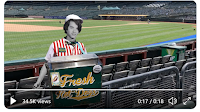If I had to pick a single moment when the world as I knew it went on indefinite hiatus, I would choose shortly after eight p.m., on March 11th, when Donnie Strack, the Oklahoma City Thunder’s vice-president of human and player performance, sprinted onto the court where his team was about to play and stopped the officials from beginning their game against the Utah Jazz. Strack was delivering the news that the Jazz center Rudy Gobert had tested positive for the novel coronavirus. Players were pulled off the court. A half an hour later, fans were told that the game had been postponed, and that they had to leave the arena. They have yet to come back. The N.B.A. season was suspended an hour later, and then much of modern life was, too. (...)
When sports resumed in the United States, during the summer, some leagues and teams sold tickets, much to epidemiologists’ chagrin. Others covered the empty seats, or left them empty. Still other teams embraced the surreal quality of our recent existence and sold tickets to cardboard likenesses. As the year closes, I’ve been thinking about the cutouts I’ll remember, and of the efforts that people made to simulate communion when the usual community provided by sports wasn’t safely attainable. There was something hopeful in them—a mix of silliness, and humility, and the sense of making-do.
A Young Tom Hanks
In early May, Dave Kaval, the president of the Oakland Athletics, received a tweet from an A’s fan, showing a shot of a Borussia Mönchengladbach game. “I wrote back almost immediately saying what a cool idea,” Kaval told me recently. Faced with the prospect of a Major League Baseball season beginning with an empty stadium, Kaval put together a group to start sourcing and sizing cutouts.
Prices for “tickets” started at forty-nine dollars, with prices going up to a hundred and twenty-nine dollars for a spot in the Foul Ball Zone. (If a foul hit a cutout, the fan received the ball in the mail.) “I was thinking maybe a thousand” people would buy one, Kaval said. More than ten thousand fans did. A portion of the proceeds went to local charities.
Matt Olsen, the team’s first basemen, had more than twenty family members down the first baseline. There was a visitors’ section. Perhaps the most unexpected cutout was of Tom Hanks—as a peanut vendor, a job he’d held in Oakland as a teen-ager. Hanks got in touch with Kaval and ultimately sent him an iPhone shot of an old yearbook photo. He even recorded a clip of himself hawking hot dogs, which aired over the loudspeakers during the game.
The Field of Dreams
Hanks is hardly the only celebrity with his own cutout. The Phillies stuck Ben Franklin, a Philadelphia native, into a blue plastic seat in Citizens Bank Park. Walt Whitman was there, too. In Australia, a prankster submitted a cutout of a dead serial killer for a rugby match. Being alive, after all, was not a prerequisite for attending a sporting event this year.
Some fans took advantage of this unusual fact to memorialize those they’d lost. The images of dozens of deceased fans were scattered across football and baseball stadiums. Grieving parents could see cutouts of children who’d loved the game. Grandparents sat next to kids they’d never had a chance to meet. A father was reunited at Oracle Park with a son who had died at the age of twenty-two—and who had loved the game so much that his ashes had been spread in the bay beyond the right field wall.
by Louisa Thomas, New Yorker | Read more:
Image: Twitter
